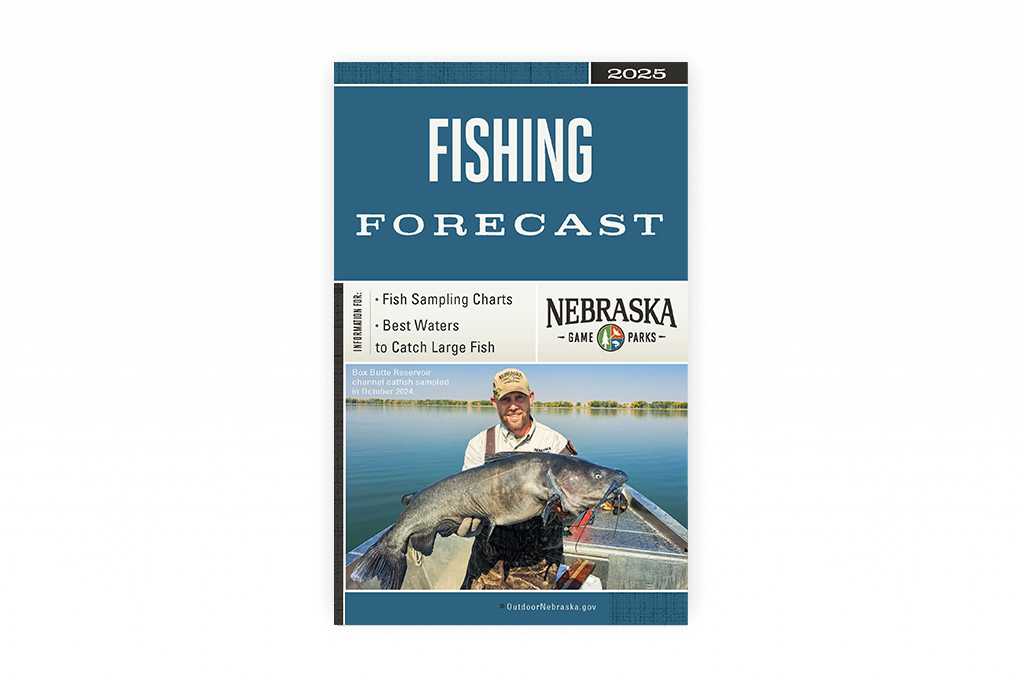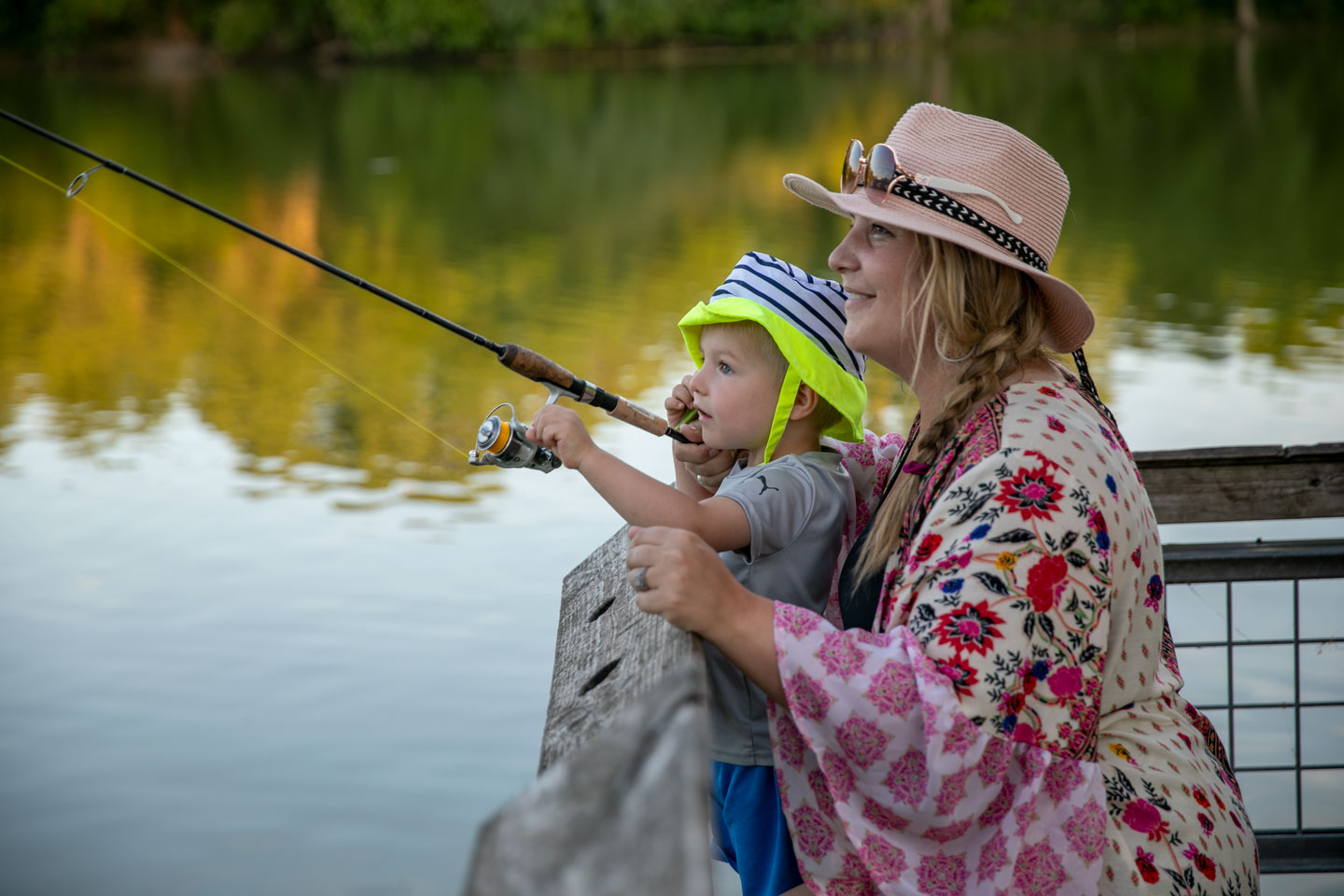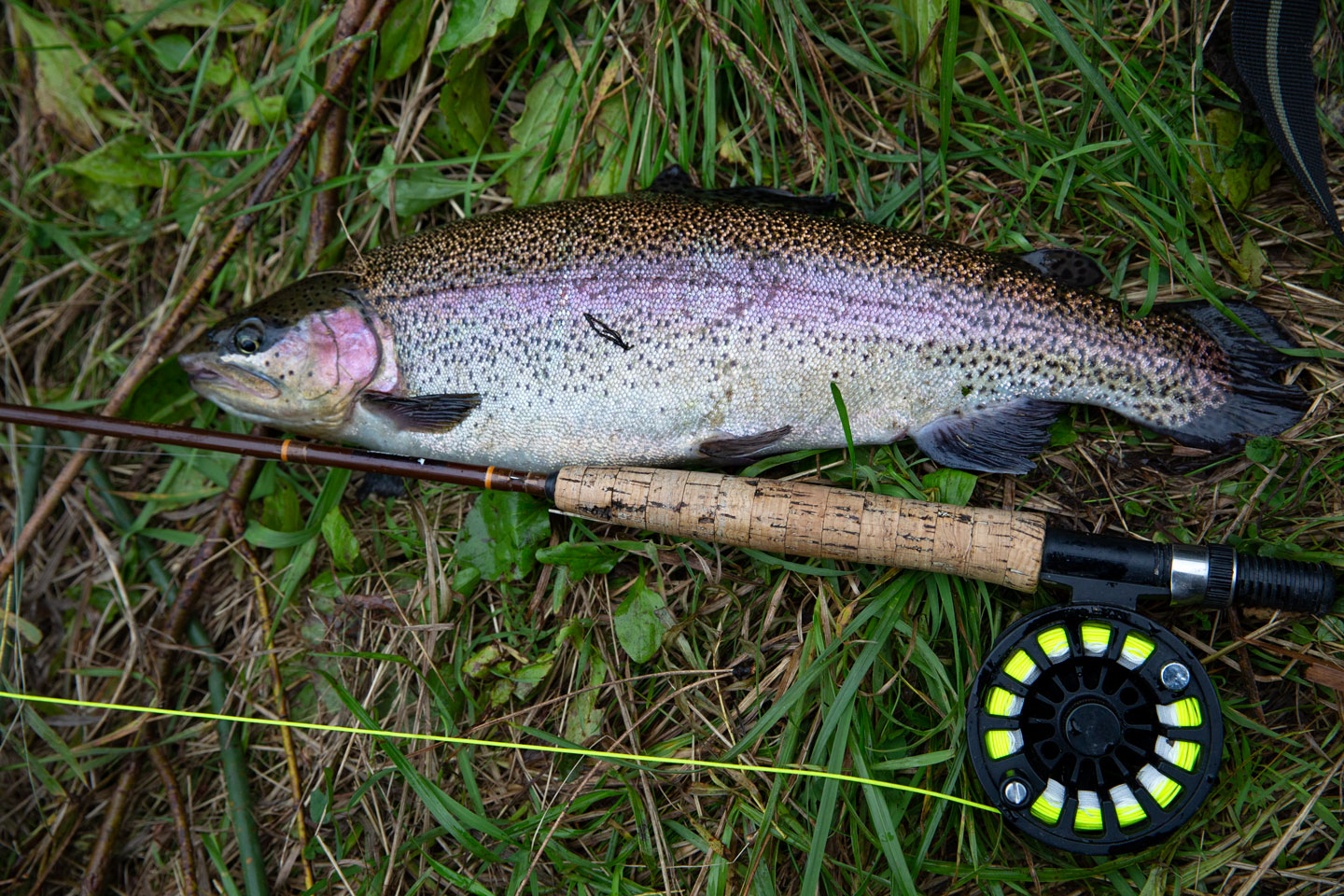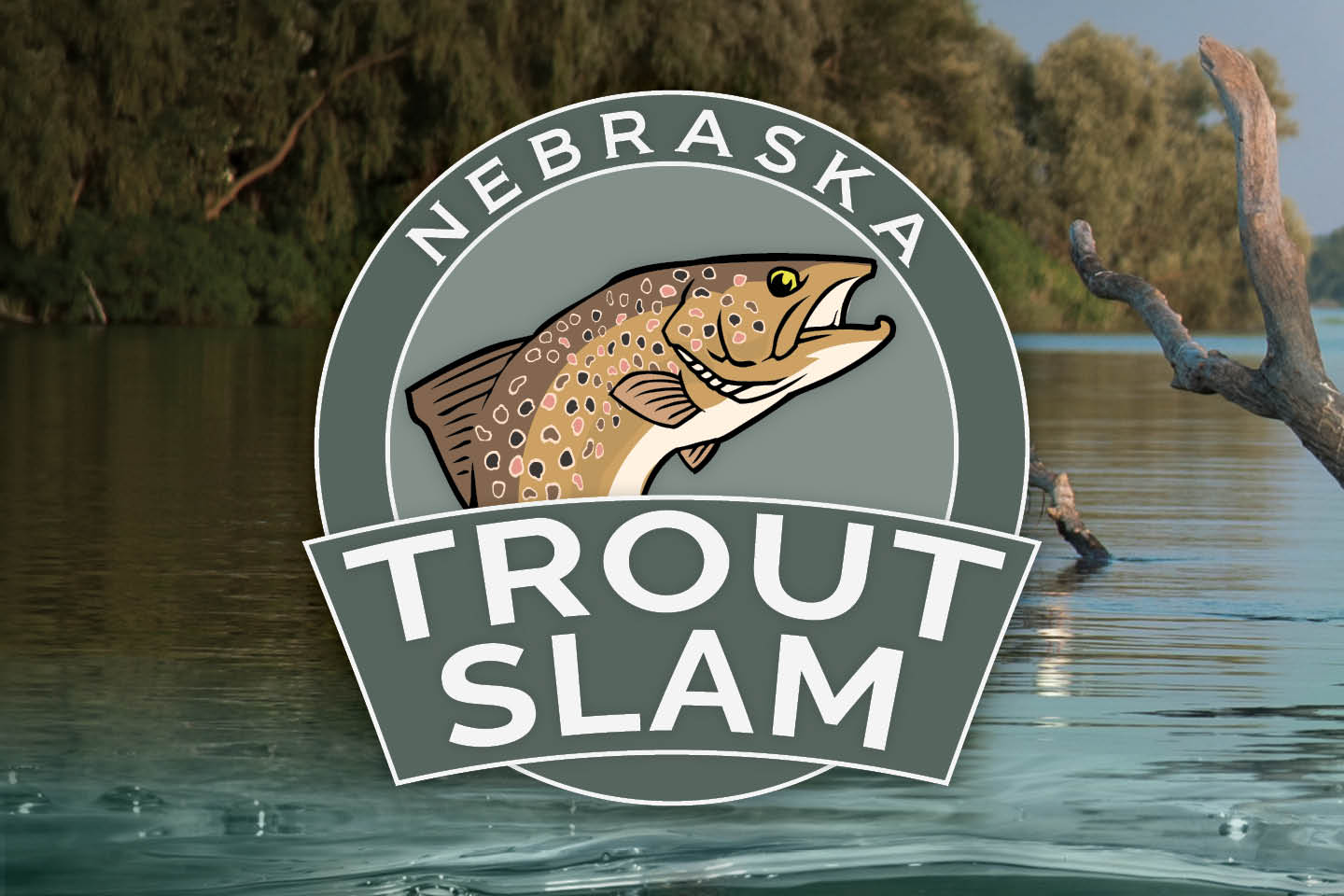Fishing Forecast
The annual Nebraska Fishing Forecast includes useful information about the best current locations and seasons to catch certain fish species.

Fishing Forecast
With about 450 lakes and streams open to public fishing, deciding where to fish in Nebraska can sometimes be challenging. Our annual fishing forecast can help. The forecast contains research statistics and graphs to explain sampling information for important sport fish species sampled across Nebraska from the previous year along with useful tips from our fisheries division staff.
Take your fishing to the next level
Discover the best waters to fish for a particular species and other useful tips. Below is a breakdown of the annual fishing forecast by species.
Nebraska’s largest waters are the state’s best walleye habitats and consistently provide the best fishing. Walleye populations in these waters are dynamic, often changing in response to fluctuating water levels. The highest total sampling rates of walleyes in the fall of 2024 were at Winters Creek, Merritt, Oliver, Elwood and McConaughy. Merritt, Winters Creek, Elwood and Johnson will be particularly good for 15- to 20-inch walleyes in 2025.
Anglers targeting big walleyes should plan trips to McConaughy, Merritt and Elwood and Sherman reservoirs. Smaller waters are less ideal walleye habitats, but several of those will offer some walleye opportunities this year. Kramper and Conestoga will give anglers a chance to catch walleyes in eastern Nebraska. Oliver Reservoir in the Panhandle again had a lot of walleyes sampled last fall, most of them less than 15 inches long.
White bass also are open-water predator fish that thrive in Nebraska’s largest reservoirs. Water level fluctuations also drive reservoir white bass populations. The most white bass in 2025 will be found at Sherman, Sutherland, Johnson, Swanson, and Red Willow. Sherman, Johnson, Harlan, Calamus and Swanson reservoirs will be particularly good for white bass larger than 12 inches this year. For white bass larger than 15 inches, anglers should target Johnson, Minatare and Enders.
Wipers are white bass x striped bass hybrids, and, like their parent species, also are most successful in open-water habitats – Nebraska’s largest reservoirs. Swanson, Red Willow and Medicine Creek will offer high numbers of wipers in 2025. Harlan also will have numbers of wipers this year, as well Elwood and Davis Creek. Anglers looking for trophy wipers should spend time on Johnson, Swanson, Elwood, Branched Oak and McConaughy. In eastern Nebraska, Branched Oak and Zorinsky will provide anglers opportunities to catch wipers while recently stocked Wanahoo already has good numbers of small wipers. All wipers caught at Branched Oak and Zorinsky must be immediately released.
Anglers can take their kids to catch some “sunnies” on just about any small body of water in Nebraska. The best waters always are those that produce numbers of 8-inch and larger bluegills. Small- to medium-size reservoirs offer some of the best bluegill fishing every year, with Summit, Walnut Creek, Skyview and Yankee Hill topping the list in 2025. Nebraska’s Sandhills lakes offer lower densities of bluegills but can produce some trophy ’gills, with the biggest exceeding one pound. The best Sandhills lakes this year will be Frye and Swan. Anglers should remember bluegills that big are rare fish and worthy of having a picture taken and then returned to the water. Pits and ponds like Verdon, West Wood River, and Coot Shallows also will produce some quality bluegills this year.
Crappies are another panfish that can be found throughout Nebraska, with the quest being finding waters that will produce fish larger than 10 inches. Davis Creek, Olive Creek, Yankee Hill, Iron Horse Trail, Sherman and Verdon will be some of the state’s best crappie waters in 2025. Other waters that will be good for crappies this year will be Red Willow, Willard Meyer, Timber Point, Homestead and Meadowlark. Again, Sandhills lakes tend to have lower densities of panfish like crappies, but can offer some of the biggest, fattest, black crappies in the state. Home Valley and Big Alkali lakes will be the best of the Sandhills crappie fisheries this year.
Water bodies that offer stable water levels, clean water and an abundance of shallow-water cover, especially aquatic vegetation, are those in which largemouth bass thrive. In Nebraska, small reservoirs, Sandhills lakes, pits, and ponds tend to provide the best of that habitat. Some of those waters can have high densities of bass, which favors excellent panfish fishing as largemouth bass keep panfish numbers in check. However, waters with lots of bass may not necessarily be the best for big bass. When looking at the sampling data for the best bass waters, those with the highest numbers of bass may not offer opportunities to catch fish larger than 15 inches.
On the other hand, lower densities of largemouth bass can offer the best chances to catch bass larger than 15 inches. Some small- to medium-size reservoirs that will be particularly good this year include Wolf Wildcat, Czechland, Stagecoach, Walnut Creek and Prairie Queen. Pits are some of the best bass fisheries in the state; Blue Hole, North Platte I-80 and Fort McPherson will offer some excellent bass fishing in 2025. In the Sandhills, Rice Lake will be a good bet for 15-inch and larger bass. Private waters always produce some of the best bass fishing in the state, and many Nebraska anglers have permission to fish at least one of those privately-owned waters. Some private pits and ponds have been enrolled in the Open Fields and Waters program and are open to public walk-in access. Refer to the Public Access Atlas.
Channel catfish are a popular fish in Nebraska and are found widely across the state. Conestoga, Minatare, Big Alkali, Pawnee and Willow Creek will offer good numbers of 16-inch and larger channel cats in 2025. For cats longer than 24 inches, anglers should plan to fish Wellfleet, Kramper, Box Butte and Willard Meyer this year. Voluntary catch and release of large, trophy catfish is a practice that should be considered by anglers on any Nebraska water as it takes years to grow channel cats that large. Special regulations apply to channel catfish caught at Merritt and Box Butte. For a different experience, try Nebraska’s warm-water rivers like the Missouri, Platte, Elkhorn or Niobrara, as they also are excellent catfish fisheries. There are some areas where public access is available on Nebraska rivers, check out the Open Fields and Waters program for access to warm-water streams and rivers on private lands.
Nebraska also has waters that support cold-water fish year-round where anglers can pursue a Trout Slam catching rainbows, browns, brooks, and possibly even cutthroats, tigers (brown trout x brook trout hybrids), and cutbows (cutthroat x rainbow hybrids). Most of the cold-water trout streams are in western and northern parts of the state; the East Branch of Verdigre Creek, Long Pine, Soldier and Ninemile creeks are favorites among trout anglers. In 2025, the rainbow trout fishing at Lake Ogallala will be excellent. Anglers might even catch some cutties from the White River and the Wood Reserve Ponds in the Pine Ridge.
Diverse fishing opportunities
Nebraska is known for its diverse fishing opportunities. Besides the species highlighted above, there are a variety of other fish that can be pursued. Learn more about these additional species below.
Redear sunfish are another species of sunfish species in Nebraska that can be caught at Louisville #3, Prairie Queen and Bowling.
Smallmouth bass can be caught at Maloney, Big Elk and McConaughy, as well as the Missouri River in northeast Nebraska.
Blue catfish can be found in reservoirs like Medicine Creek, Pawnee, and Swanson, but look to the Missouri River in southeast Nebraska for the biggest blue cats in the state – some weighing triple digits.
Flathead catfish are another species of large catfish that can be found in the Missouri River, as well as in reservoirs like Pawnee, Swanson, Medicine Creek, Branched Oak, and the Tri-County canal system. All flatheads at Branched Oak must be released immediately after capture and anglers should consider releasing big flatties on other fisheries as well.
Fishing for sauger will be best on Lewis and Clark Reservoir and the Missouri River in northeast Nebraska, but Johnson Reservoir and the Tri-County canal system also have good numbers of sauger.
Saugeye are a walleye X sauger hybrid and stocking is producing some excellent angling opportunities for them at Willow (WMA), Big Alkali, Wellfleet and Pawnee.
Yellow perch are a tasty and popular panfish. Good yellow perch fishing will be found at Dewey Lake in the Nebraska Sandhills. Big Elk also will offer anglers some yellow perch this year.
Sandhills lakes are some of the best Northern Pike habitats in the state, as well; Clear (FWS) and Peterson lakes will provide some pike fishing in 2025, along with Grove Reservoir. Reservoirs in southern and eastern Nebraska are typically too warm for cool-water northern pike, but Flanagan is relatively new and has some pike habitat and pike fishing right now. All pike are required to be released at Flanagan.
To catch this trophy, toothy predator, anglers should target Merritt, Calamus and Zorinsky reservoirs, as well as Mormon Island West and Grand Island’s L.E. Ray Lake. Cottonwood-Steverson also has an excellent muskie population.
Related content
Find additional resources to make your fishing trip a success.
Fishing permits
Purchase stamps, resident and non-resident fishing permits here.
Advertise in our guides
Reach a highly targeted audience of hunters and anglers. Learn more from our guide books media kit.




